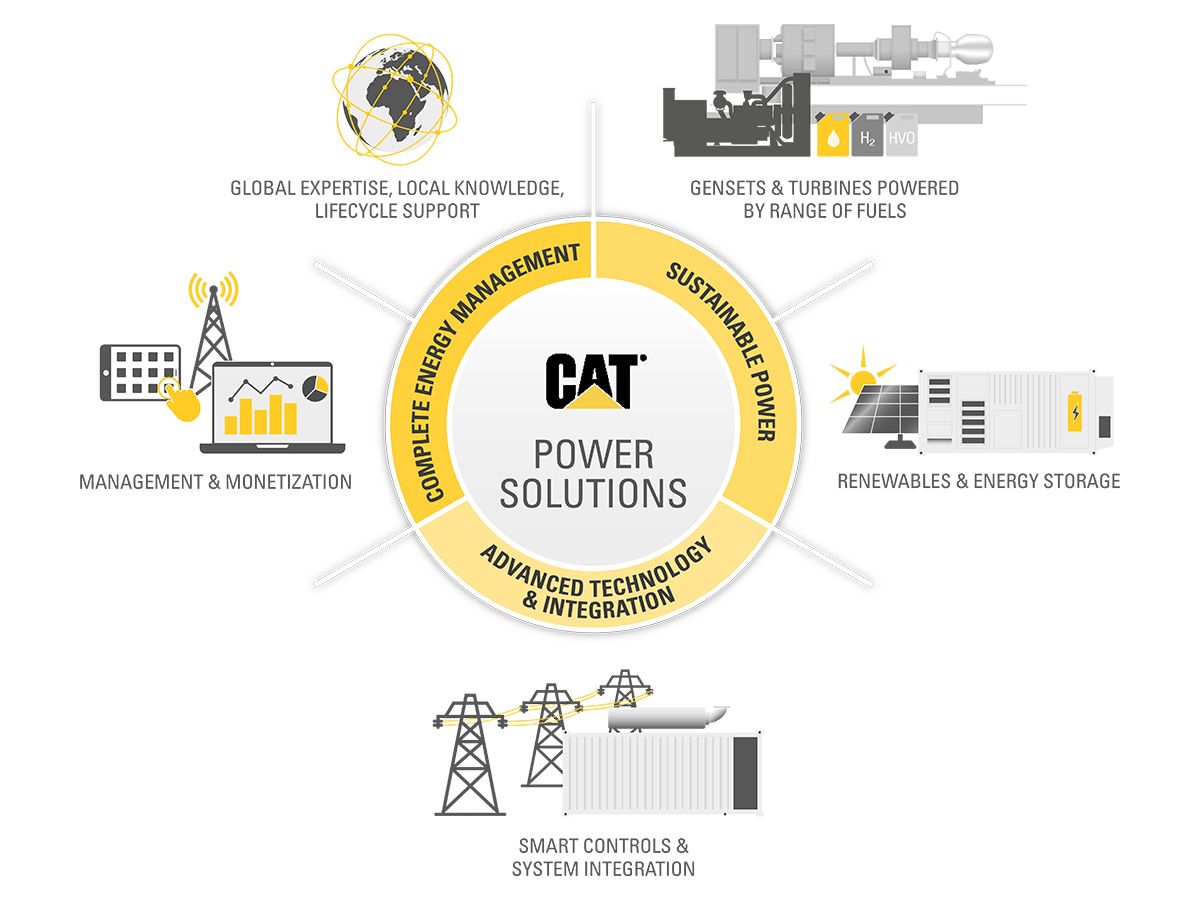UNDERSTANDING MICROGRIDS AND HYBRID ENERGY SOLUTIONS
Microgrids are self-sufficient energy systems capable of generating their own power, traditionally via generator sets or turbines. Microgrids can operate independently or in conjunction with the electrical grid/utility.
Hybrid energy solutions (HES) are microgrids that involve a combination of power sources. They can combine proven cost-effective renewable energy from wind or solar sources with conventional diesel- or gas-fueled generation. They can also employ energy storage to add power system stability and enable further energy cost reduction.
Distributed energy resources (DERs) are typically small-scale microgrids or hybrid energy solutions that are usually situated near sites of electricity use, bringing energy generation closer to the point of use.
SEE WHY YOU CAN TRUST YOUR HYBRID ENERGY PROJECT WITH PETERSON
Fully integrate renewable energy, battery energy storage, and conventional power generation with a full range of Cat Hybrid Energy Solutions from 10 kW to 100 MW. We are with you at every phase of your hybrid energy project—from conception to regular service for optimal operation to product upgrades, financing services, warranty, service agreements, and parts availability. We will customize our hybrid energy technologies to meet your business and industry needs.

MAKING SUSTAINABLE PROGRESS POSSIBLE.
Caterpillar is at the forefront of the energy transition, integrating renewable power with smart energy storage and conventional diesel-, gas-, or renewable-fueled power generation to provide:
- Increased energy efficiency with no reliance on the grid and optimal total cost of ownership.
- Efficient power that can be produced where and when it’s needed without transmission lines and transformer losses.
- Increased renewable energy source utilization and power system stability, further enabling energy cost reduction.
- A high performance, scalable system designed and built using standardized building blocks that are easy and quick to install even in challenging environments.

BATTERY ENERGY STORAGE SYSTEMS (BESS)
Maximize Resiliency and Savings with Battery Energy Storage Systems (BESS)
Energy storage systems are a key component in a hybrid microgrid and guarantee short-term backup power. Peterson can provide on-site energy storage systems to help stabilize transient loads, supply and absorb alternating current (AC) power, increase renewable energy source utilization, and transfer energy from time-of-generation to time-of-use. Stored energy can also be used to participate in grid services markets to avoid costs or receive financial compensation.
Benefits of Battery Energy Storage Systems:
- Robust and pre-engineered containers that are easily installed on-site
- Able to be operated in tandem to provide increased power output and/or increase the battery energy capacity
- Allow optimized generator set operation
- Allow for renewable integration
- Suitable for grid integration and genset transient assist
- System design integration with enhanced safety features
- Factory prepackaged and tested
- Reliable, modular, and scalable

Generator Sets and Flexible Fuel Options
Traditional Power Generation and Renewable Liquid Fuels
Cat hybrid energy solutions enable seamless renewable energy integration with traditional power sources, such as on-site generator sets. These generator sets can provide a much-needed backstop when renewable resources, including wind and solar, are not available.
Flexible Fuel Options
All Cat diesel generators can run on biofuels and have accommodated the use of biodiesel and hydrotreated vegetable oil (HVO) for over a decade. These fuels are available now and can help reduce lifecycle greenhouse gas emissions compared to diesel.
Cat gas generator sets can also run on a variety of lower-carbon intensity fuels depending upon the model. These include:
- Natural Gas – One of the cleanest burning fuels, natural gas can help you meet strict emission and environmental regulations compared to diesel.
- Biogas – Byproduct gases from agricultural, food processing, and industrial processes are captured to fuel Cat low-energy fuel generators.
- Propane – Propane can be used in applications where natural gas is not available.
- Hydrogen – Renewable hydrogen and blends of hydrogen and natural gas are among several alternative fuels to help achieve sustainability goals.
 WARNING
WARNING